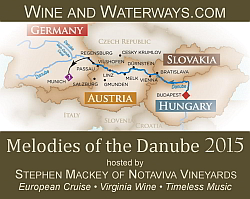
This week I was invited to an intimate tasting of German and Austrian wine hosted by
Rudi Wiest Selection, the "leading importer of fine German wines in the United States market". The tasting was held at
B Too, the latest restaurant from Chef Bart Vandaele (
Belga Café) and featured wine from three young winemakers who have just ascended to the wine making thrones for their respective family operations: Johannes
Hasselbach,
Gunderloch in Nackenheim, Rheinhessen, Germany; Max von Kunow,
von Hövel in Oberemmel, Mosel, Germany; and Alwin Jurtschitsch,
Jurtschitsch in Langenlois, Kamptal, Austria. These three are not only friends, but family considering that Hasselbach's sister, and initial heir to the family's wine making venture, married Jurtschitsch with von Kunow serving as his best man. Before taking over their respective wineries, each traveled and interned at wineries from Australia and New Zealand to Canada. And surprisingly, a common thread was that each winery had become quite large under their parents such that the new wine makers turned towards more traditional methods. For instance Alwin Jurtschitsch re-introduced more organic farming methods and Johannes Hasselbach to

Since these three obviously spend quite some time together discussing and sampling wine, one topic that constantly surfaced was a particular wine the result of the vineyard site or actions by the winemaker. They decided to experiment and shared a portion of their 2012 grapes (the first year each took over operations) grown in their grand cru vineyards in a project called Wurzelwerk or root work. Each then made three separate wines using the grapes from each winery. They attempted to eliminate by letting the grapes ferment outside using the yeast clinging to the grape's skins. The result, I don't know. I was unavailable for the evening event which featured these wines but will link to Christian Schiller who posted about the project
here.

Instead this lunch focused on two wines from each winemaker from their estate grapes. We started the lunch with the Jurtschitsch Grüner Veltliner Loiserberg 2012 Kamptal DAC Reserve, Erste Lage and 2011 Zobinger Heiligenstein Kamptal Reserve Reisling, with Alwin introducing us to their 150 year old winery. The winery itself includes a 700 year old cellar and is located in the Kamptal DAC, northwest of Vienna and west of . The steep hills of Heiligenstein ("holy rock") contain a unique blend of desert sandstone and volcanic soil which adds a salty minerality to the Riesling - a perfect match with our oysters appetizer. The Riesling also possessed a green apple flavor with plenty of acidity accumulated from the cool nights. The Grüner Veltliner has a more floral aroma, with a silky texture after being fermented in neutral oa and spending 10 months on its lees. These are two delicious wines.

We then moved to the two Rieslings from
Gunderloch, with Johannes describing the winery's three vineyards sites situated above the Rhine river and the 120 year family history operating the winery. An interesting story is that the harvest help has traditionally come from Poland, and as that country has become wealthier, the Polish workers still arrive for harvest, now using their vacation time to pick grapes. The first Riesling was the "entry" level 2012 Estate Dry Riesling ($15), but there was nothing entry level about this wine. It's a blend of grapes from the three vineyard sites and starts with green apples finishing in firm acidity. Very tasty and refreshing. The second wine was my favorite of the lunch, the 2012 Gunderloch Riesling Dry GG, Pettenthal ($42). The Pettenthal is the only site on the Rhine with red clay soil and this single vineyard wine is equally fruity and acidic. But it's the creamy texture that allows the wine to melt in your mouth.

The final presentation was given by Max von Kunow who brought along one
von Hövel produced by his father and a second of his. The von Hovel estate was a acquired from Napoleon Bonaparte in 1806 ( a mini
Louisiana Mosel Purchase) and Max is the 7th generation wine maker. Before Bonaparte confiscated the land, the manor house and cellar was the retreat for St. Maximin and are over 800 years old. And the wines match the winery's amazing history, these extremely low alcohol wines (7.5%-8%) are extremely fruity with a sense of sugar - yet 100% bone dry. The elder Kunow's wine was the 2008 von Hovel Riesling Kabinett, Scharzhofberger ($15) and has a peachy-apricot flavor, followed by a creamy mid and a refreshing acidic finish. The younger Kunow's 2012 von Hovel Riesling Spatlese Dry, Estate ($35) is all tropical fruit, again a creamy mid, with balanced acidity. There's no way these flavors come from an 8% alcohol dry wine. Pretty amazing.
If you have a chance to find these wines from
Rudi Wiest Selection or a retailer, grab them. I learned today that the 2008 von Hovel Riesling Kabinett, Scharzhofberger is available online at
Last Bottle. And I hope to post more on the Wurzelwerk project. Cheers to German and Austrian wine.
 The Taunus hills, Odenwald, and Hunsrück Mountains shelter vineyards from harsh weather, giving Rheinhessen a mild climate compared to the rest Germany, with a relatively long growing season. Annual precipitation is also relatively low, roughly 500mm, making it one of the country's driest wine producing areas."
The Taunus hills, Odenwald, and Hunsrück Mountains shelter vineyards from harsh weather, giving Rheinhessen a mild climate compared to the rest Germany, with a relatively long growing season. Annual precipitation is also relatively low, roughly 500mm, making it one of the country's driest wine producing areas."



















